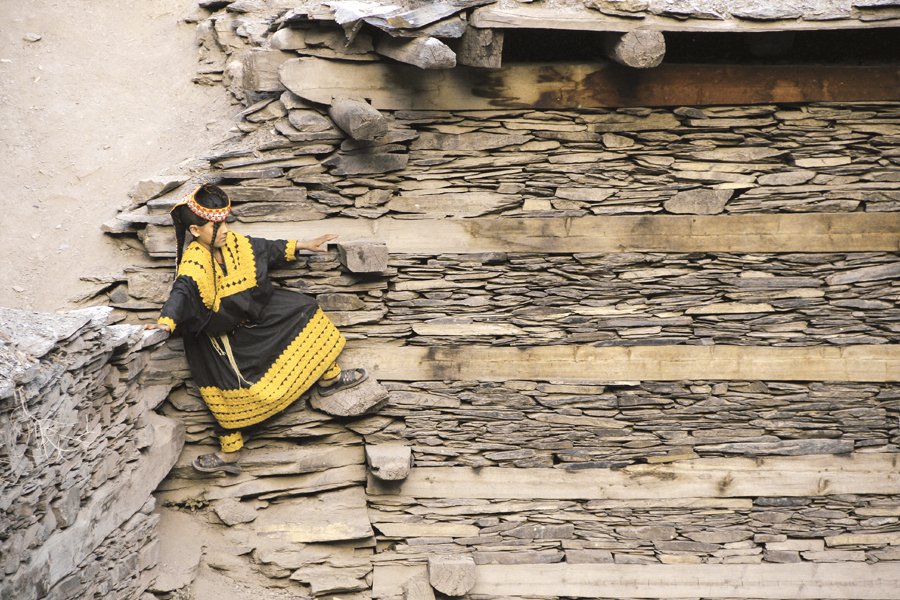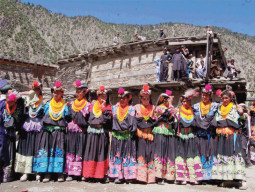
“Eesshhh-paaata” is how the Kalashis will greet you and welcome you to take a glimpse into their colourful lives. Tucked away in the Kalash Valley, Chitral district of Khyber-Pakhtunkhwa, these people celebrate life one ritual at a time.

Education is considered important by the tribe and children are sent to government or private schools located in the valley. Some even proceed to acquiring a graduate degree from universities spread across the country. PHOTOS: DANIAL SHAH
Inhabitants of the valleys of Birir, Bumburet, and Rumbur, the Kalashis speak the Indo-Aryan language, Kalasha, which bears close resemblance to ancient Greek. Although many researchers have drawn parallel comparisons to Mediterranean cultures, mainly Greek, owing to their coloured eyes, light skin and sandy hued hair, the origins of the tribe are still shrouded in myth and mystery. Even though they claim to be heirs of Alexander the Great or his generals, little has been proven about lineage in the absence of concrete evidence. Believed to be refugees from Nuristan, in neighbouring Afghanistan, the Kalashis therefore go about their everyday lives oblivious to the curiosity that continuously draws people towards them.

The tribe is famous for its folk songs and dances during festivals. The women dance, putting their arms around each other’s waist and shoulders, and spin in twos, threes or longer lines, appearing spellbound. PHOTOS: DANIAL SHAH
For the Kalash people, life pivots around nature. They celebrate four main festivals every year — Phoo, Uchal, Chowmos and Joshi or Chilimjusht — commemorating the arrival of seasons. At the Joshi festival celebrated in spring this year, the people engaged in jovial dancing and family reunions for a successful future harvest.

When death comes to Kalash, it is seen as a release. The deceased are given a farewell in a room where the relatives circle and dance in happiness for three days before the body is taken to the graveyard. PHOTOS: DANIAL SHAH
Adhering to a polytheistic tradition, based on ancestor worship, the Kalash people worship pantheon gods and goddesses. And of particular importance are Jestak, a female spirit, protector of homes and its inhabitants and Mahandeo, a male spirit, protector of the valley and its wildlife and crops. It is the very reason that the receding population, of close to 3,000, continues to shrink, with increasing threat from traditionalists to abandon their beliefs and traditions, and forceful conversions.

A woman tends her sheep. Rearing goats and sheep is a primary source of earning, other than tourism and growing walnuts. PHOTOS: DANIAL SHAH
But even in the midst of uncertainty, the Kalash tribe continues to wholeheartedly embrace culture. Women in embroidered black gowns with elaborate headpieces called kupas, complete with layered, beaded necklaces, and men in traditional shalwar kameezes, with a feathered cap called the pakol, celebrate their unique existence in all its colourful glory. With dance and laughter they drown their sorrows and the impending threat to their existence.

A woman from Rumbur valley weaves a beaded headdress, called kupa, which takes almost a week to prepare. PHOTOS: DANIAL SHAH

Kalash girls take a break to watch their elders dance during the spring festival. PHOTOS: DANIAL SHAH

The Rumbur valley is the most traditional of all valleys, comprising 70% of the Kalash population. Wooden houses in the valley are stacked one on top of the other, such that one house’s rooftop forms the terrace for the house above it. PHOTOS: DANIAL SHAH

During the spring festival, it is a ritual that a man, or a number of men, stand in corners of the ground to protect the valley and their future harvest from evil spirits. PHOTOS: DANIAL SHAH
Danial Shah is travel writer and photographer who is always on the lookout for positive stories. He tweets @DanialShah_
Published in The Express Tribune, Sunday Magazine, March 2nd, 2014.
COMMENTS (4)
Comments are moderated and generally will be posted if they are on-topic and not abusive.
For more information, please see our Comments FAQ



































































Nice pics and write-up.
How long before this unique culture is 'assimilated' into the majority religion and dissappears? The JI have already given them an ultimatum!
Beautiful shots.....beautiful write up......
Pretty picture postcard village. Inshallah , will visit one day.